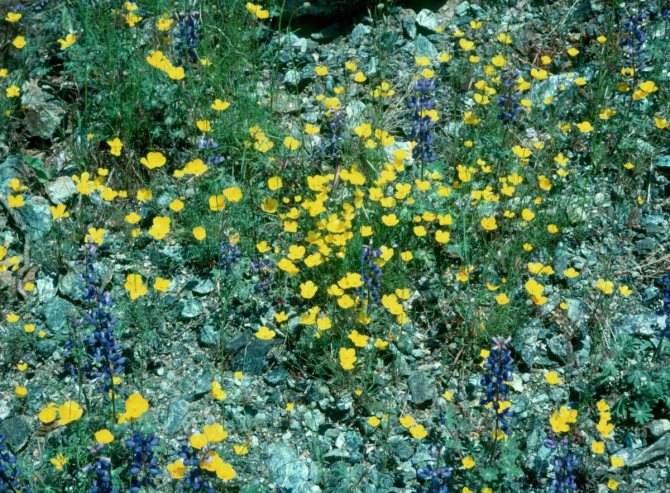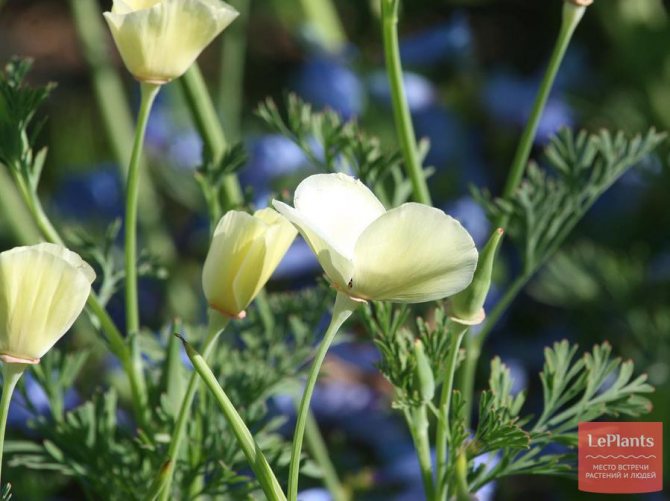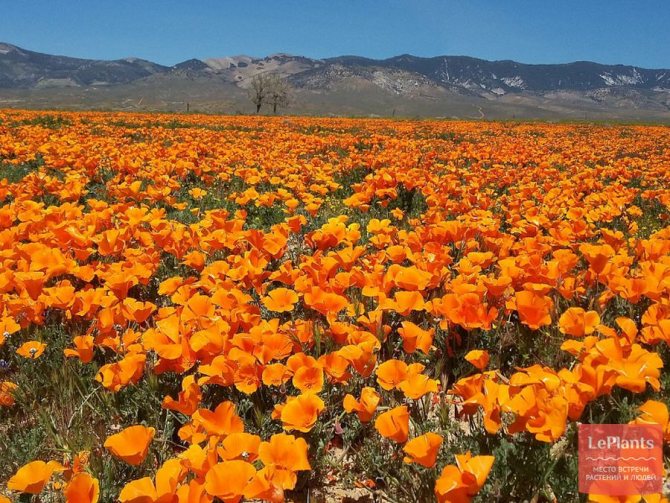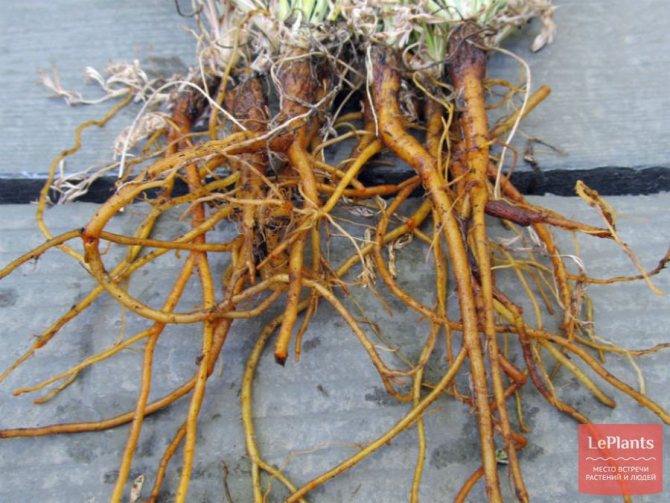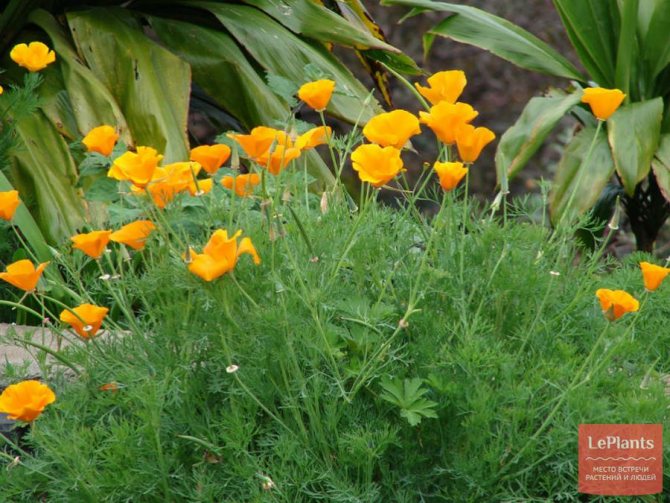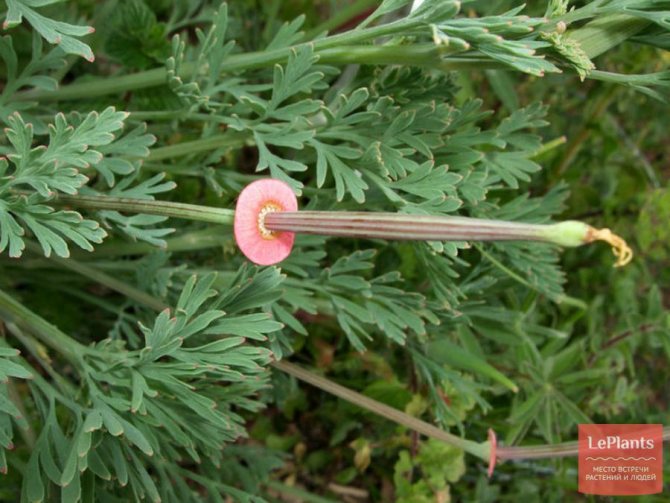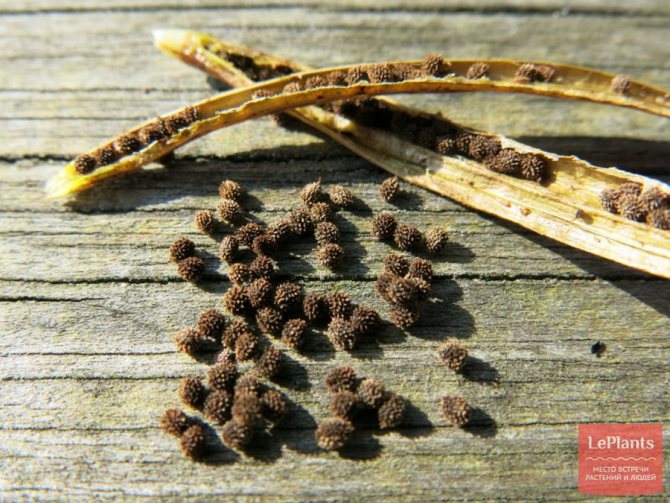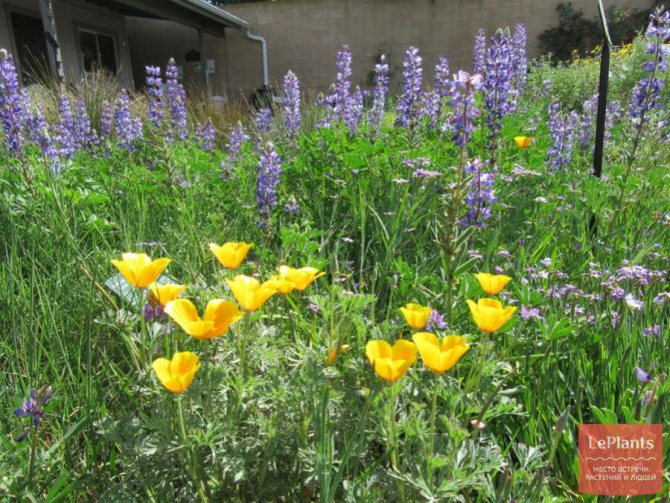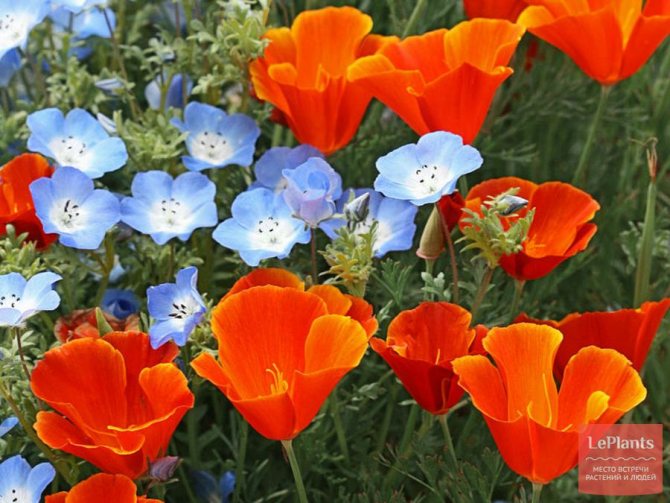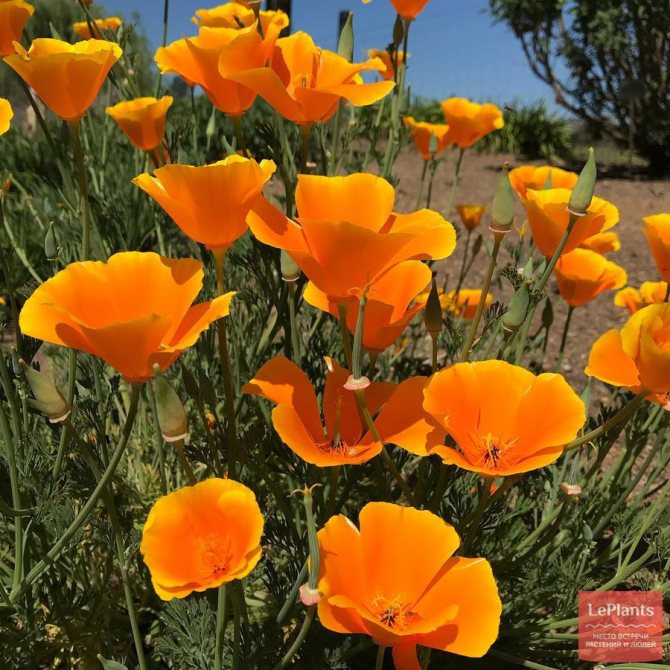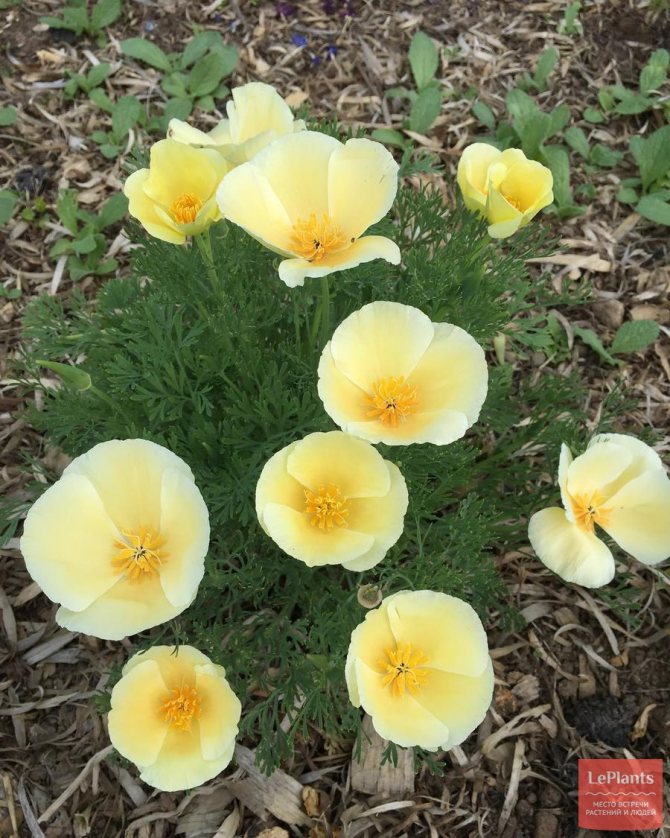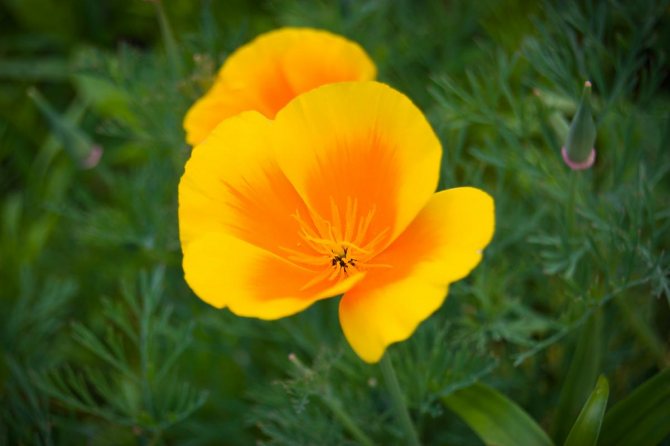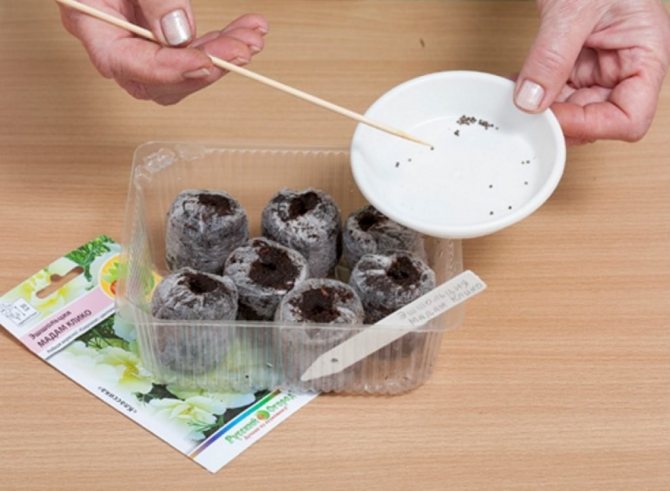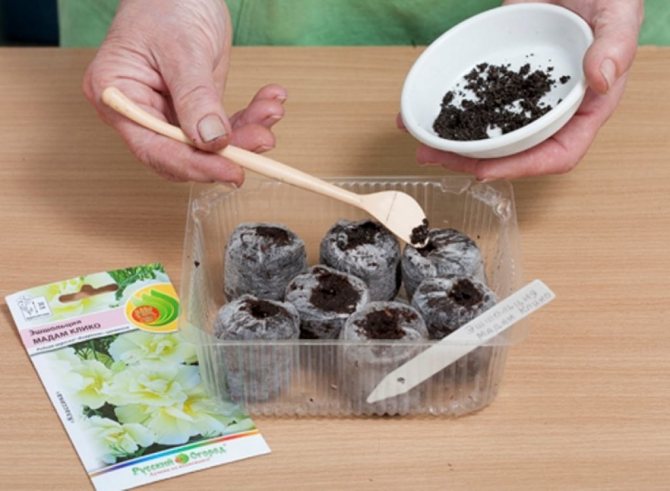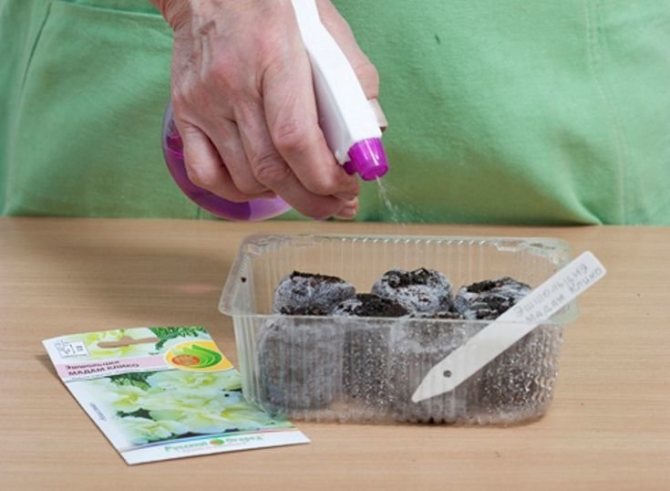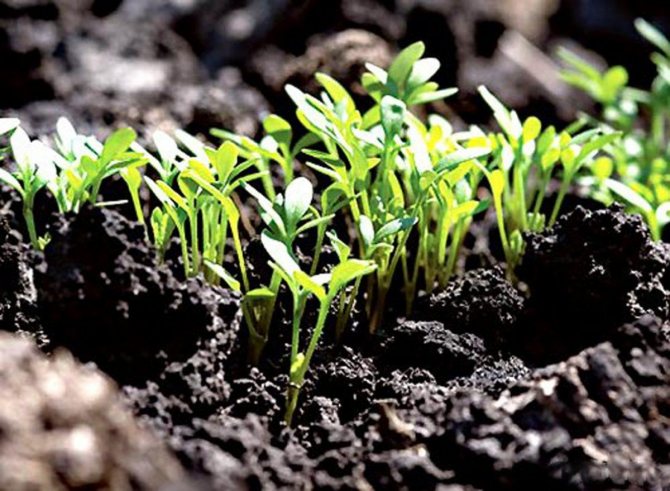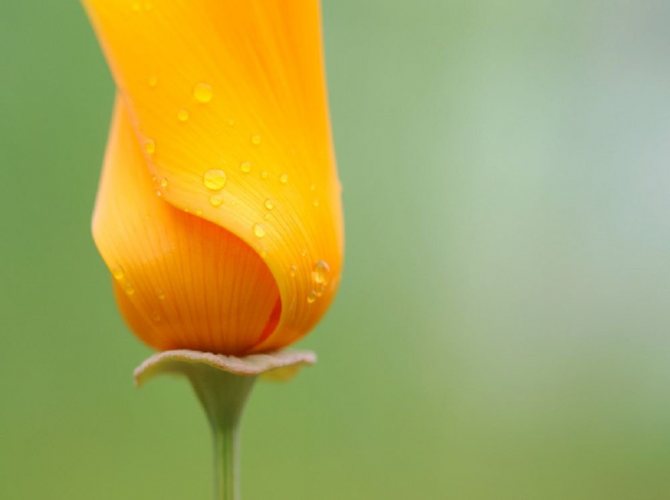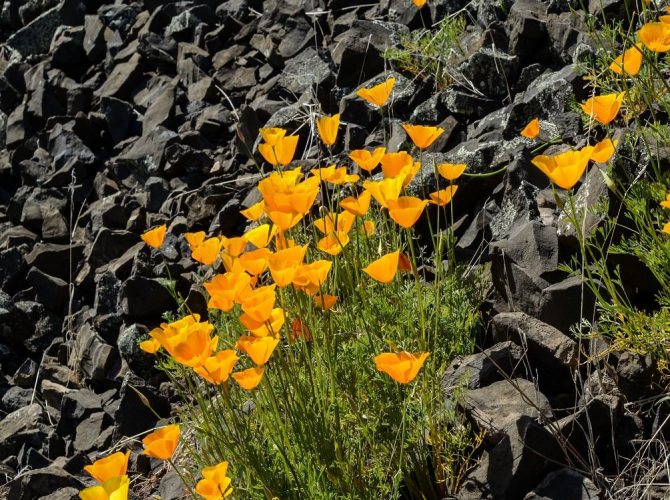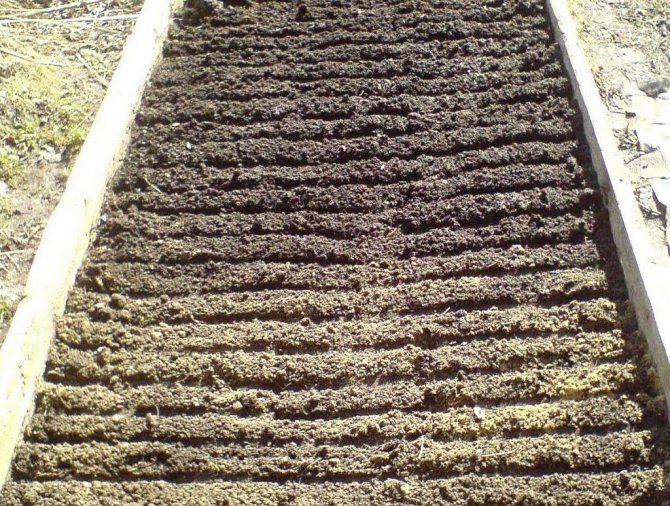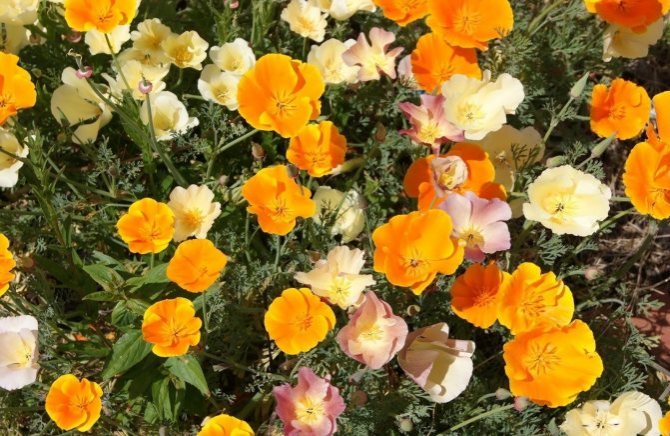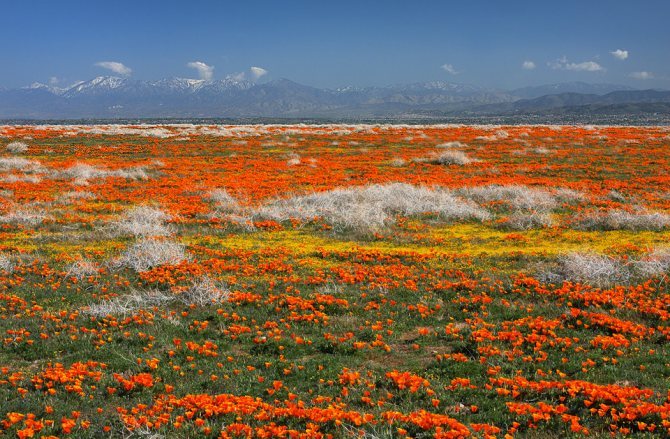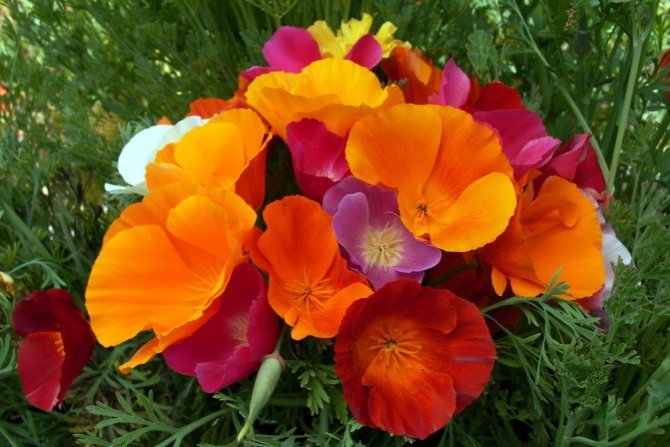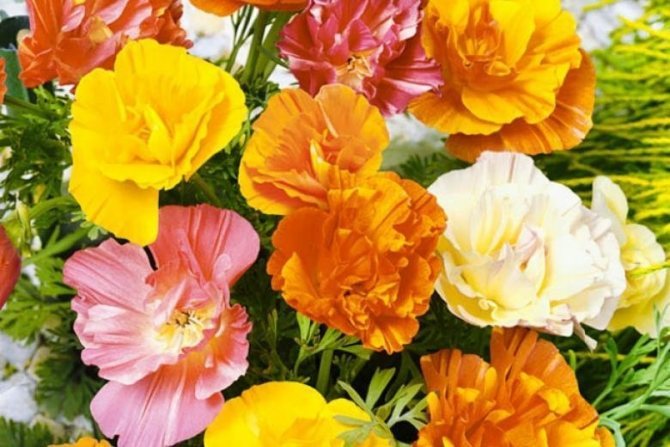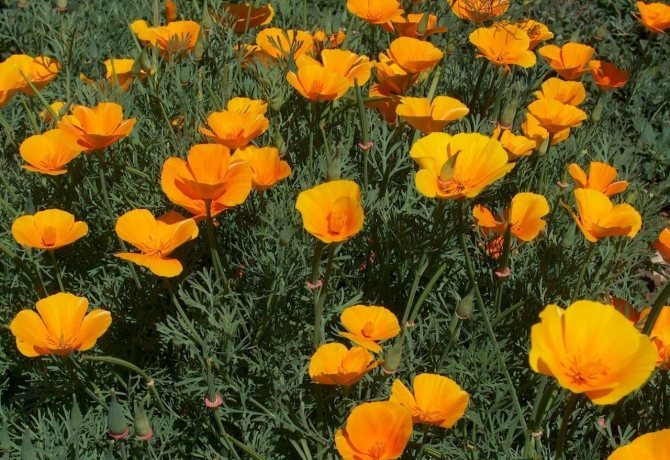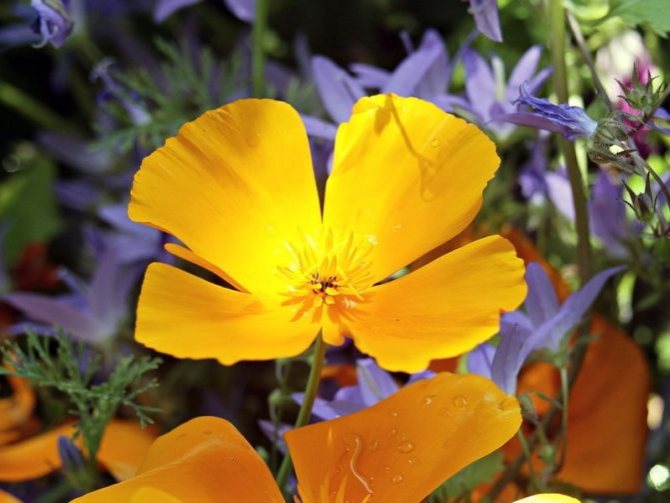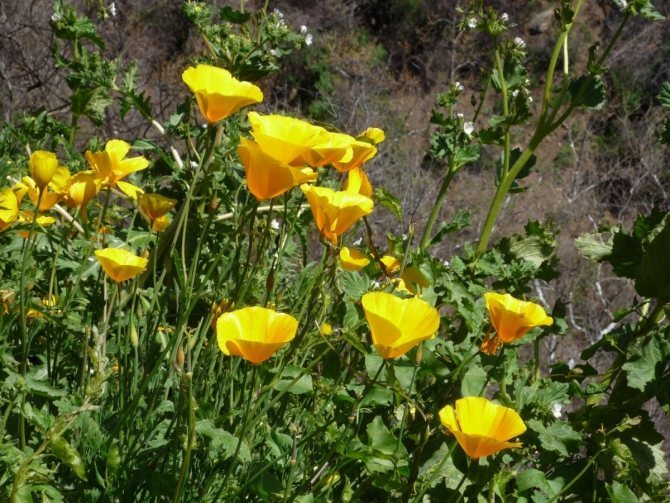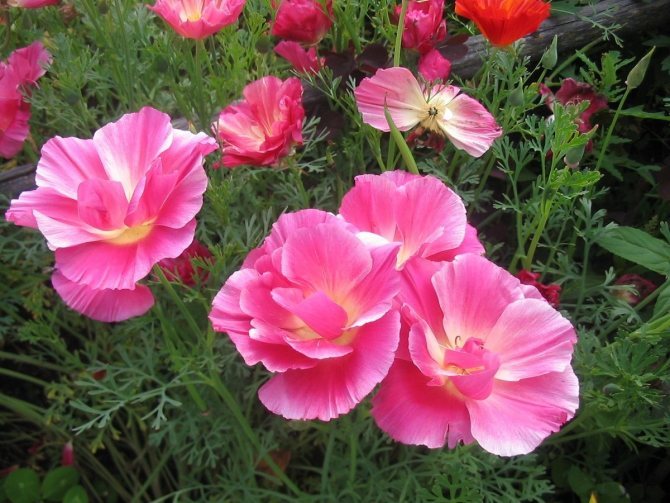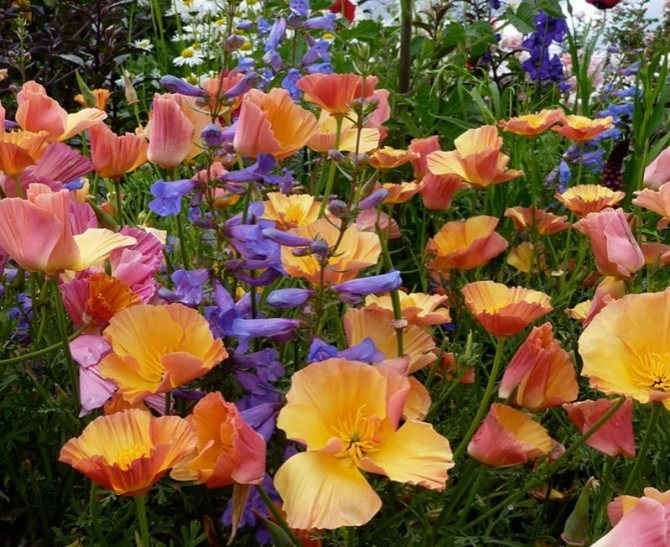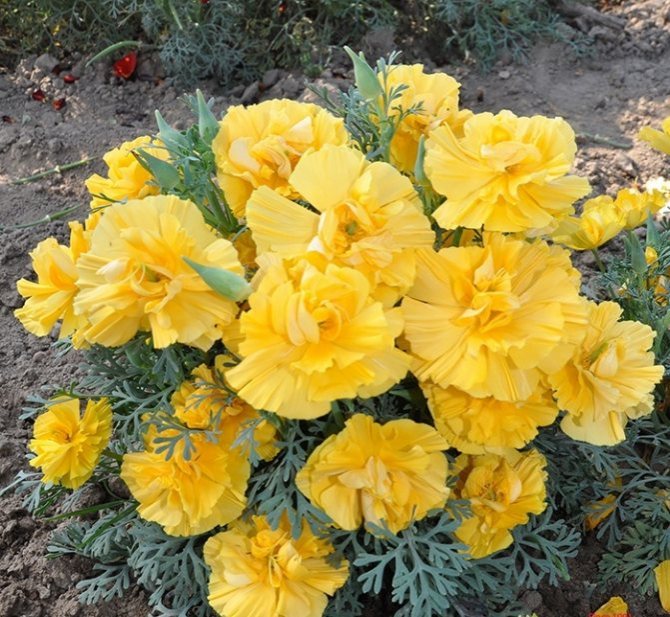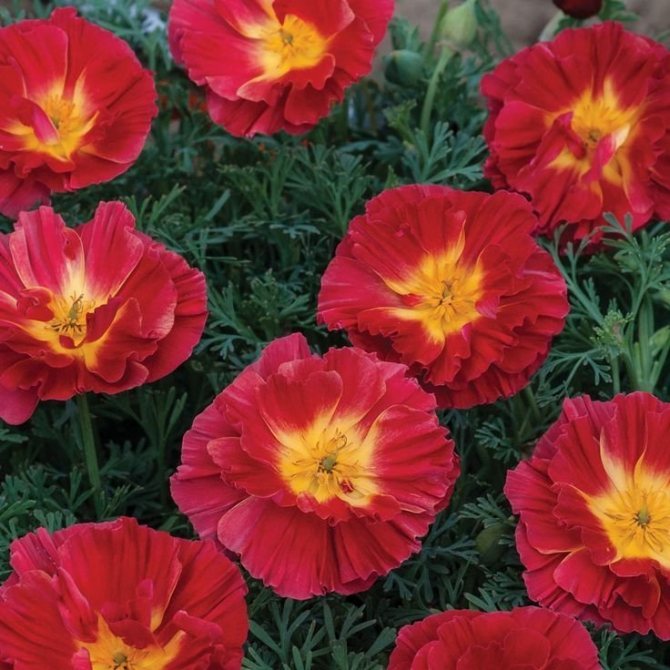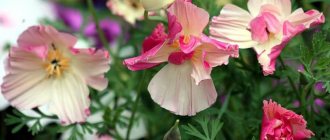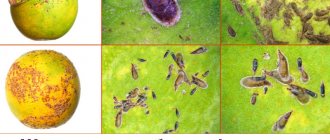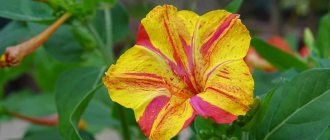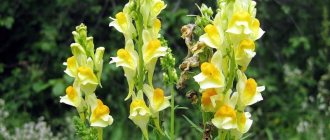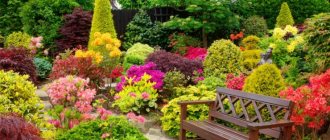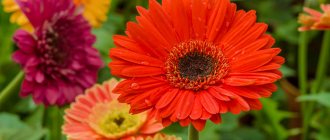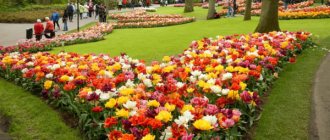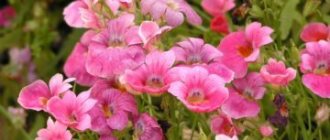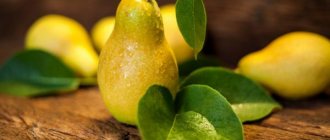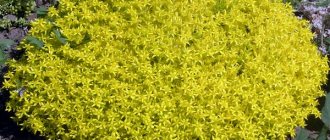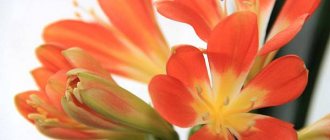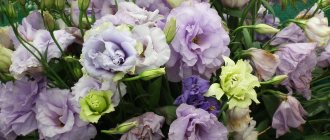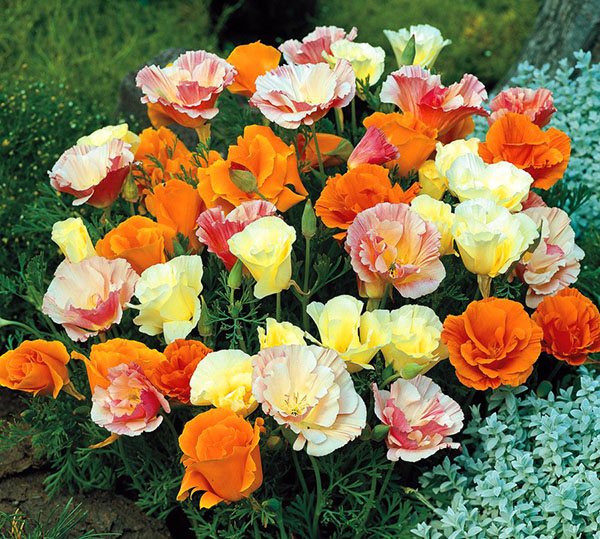
From June until the onset of autumn, in the flower beds, you can see spectacular golden flowers that strongly resemble miniature poppies. This is Californian escholzia, found more than two hundred years ago in the south of the North American continent and since then has become one of the favorite plants of flower growers all over the world.
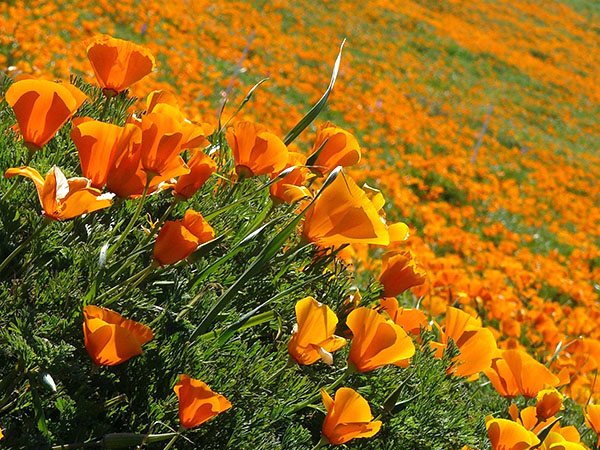

The European settlers who arrived in America believed that the new lands hid incredible treasures. One has only to dig and the bowels will give away the wealth hidden in them. Apparently, therefore, the flowers of a bright sunny hue are still called Copa de Oro, or the golden bowl, among the Spanish-speaking Americans and the Mexicans. The local population believes that gold nuggets can eventually be found where the eschscholzia opens their corollas.
Of course, this is nothing more than a beautiful legend, but in a number of regions of the United States the flower is legally protected, and in California it has been considered a living symbol of the state for more than a century.
What does the plant look like? Is there any real benefit or harm from escholzia, and how to grow a flower on your own site?
Escholzia features
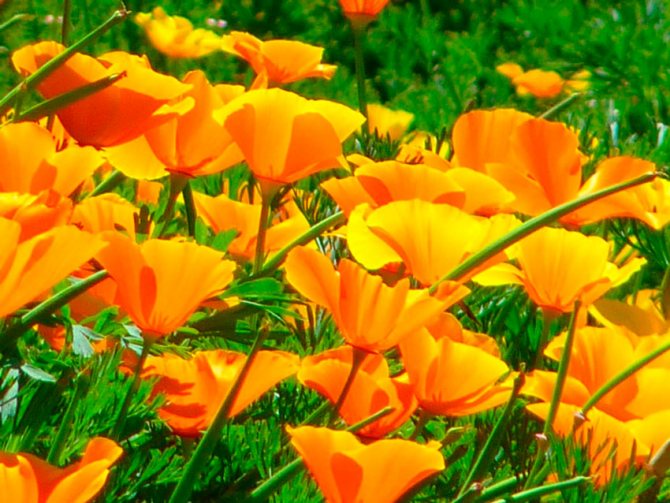

Escholzia is a herbaceous bushy perennial plant, the height of which can reach up to 0.4 m. It is cultivated as an annual flower. Taproot. There are a large number of thin stems. Openwork leaf plates are deeply dissected, they are painted in green-gray color and have long petioles. Single cupped flowers reach 8 centimeters in diameter. Flowers can be double or simple, while outwardly they are similar to poppies. Their color can be yellow, red, white, orange, and they are also painted in various shades of these colors. Such flowers have one feature, the fact is that on a cloudy, rainy, windy or cold day, as well as at night, they close. The fruit is a capsule, the size of which varies from 3 to 9 centimeters.
Seed collection
Since in our latitudes escholzia is grown as an annual crop, the issue of collecting seeds is always relevant. If you liked your plants in the flowerbed, then you should prepare the seed for the next year yourself.
To obtain seeds and prevent self-sowing, experts recommend putting gauze bags on the largest flowers after flowering. In this form, plants should wait for the seeds to ripen for a month. After the seed pods are cut off together with the sacs. The fruits are removed and dried. In the future, the seeds are stored in paper bags. They remain viable for three years. If you are not afraid of chaotically planting flowers, you can not interfere with self-seeding. Even digging the soil will not prevent new plants from emerging in the spring.
Growing escholzia from seeds
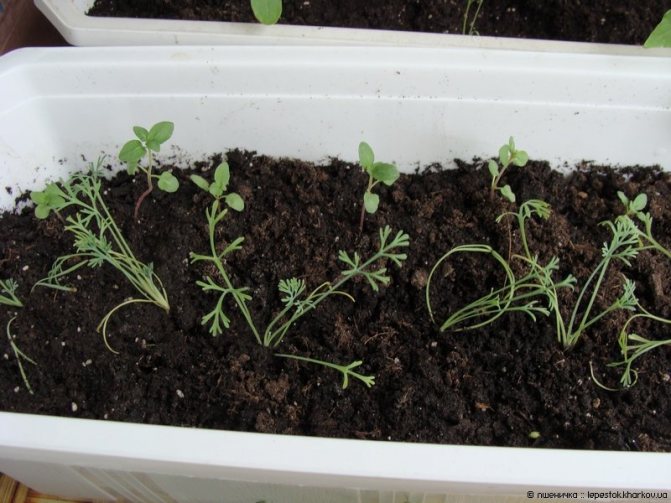

Sowing
Often, seeds are sown directly into open soil. Experienced gardeners recommend sowing escholzia before winter. The fact is that in the winter months the seeds will be able to undergo natural stratification, and in the spring powerful seedlings will appear, they will only need to be thinned out. It should also be taken into account that in plants sown in autumn, flowering begins earlier than in those whose sowing was carried out in spring.In the event that you decide to sow in the spring, in the fall, the seeds must be placed on the lowest shelf of the refrigerator, where they will stay until April. Thus, they will be stratified and perfectly preserved.
For sowing, choose a well-lit area with sandy dry soil. Then it is necessary to make not very deep grooves in it, into which small seeds are sown, previously combined with sand. They should be shallowly embedded, and then the surface of the site is covered with a layer of peat, this will help to avoid the appearance of a crust on the surface of the soil, which will become a serious obstacle for delicate sprouts. If the sowing is done in the fall, then the area must be covered with fallen leaves, and the layer must be thick enough.
Seedling
Experienced gardeners recommend resorting to growing escholzia through seedlings. With this method of growing this plant, it should be remembered that it has a rod-like long root system, which is extremely easy to injure during a dive, in this regard, it is recommended to use peat tablets for sowing. To do this, the tablets must be placed in a plastic container into which water is poured. After the tablets have swollen, the remaining liquid must be poured out of the container. Only 1 seed should be sown in 1 tablet, using a wet toothpick for this. From above, the seeds are sprinkled with a thin layer of soil for seedlings. The tablets only need to be slightly moistened from the spray bottle. The container should be covered from above with a transparent film or glass. The first seedlings can be seen after half a month, after which the shelter is removed, and the container itself is placed in a well-lit and cool (no more than 20 degrees) place. It is very simple to care for seedlings at this time: they need to be watered in a timely manner and fed with liquid mineral fertilizer for seedlings half a month after the plants have sprout. The hardening of seedlings should be started 20 days before transplanting into open soil, for this it is transferred once a day to a cool room, where it must stay for several hours. If the escholzia is hardened, then after landing in the garden, it will be able to calmly endure a decrease in air temperature to minus 5 degrees.
Seedling use
The seedling method of growing plants ensures their early flowering. It is recommended to sow the seeds in peat pots, since the long root system of the flower is easily damaged during transplantation. Sowing is done in the following way:
- Peat tablets are placed in a container filled with water. When they are well wet, the water is poured out of the container, and the seeds are placed into the tablets using a needle or toothpick.
- From above, the crops are sprinkled with soil mixture for seedlings and sprayed with water from a spray bottle.
- The container is covered from above with plastic wrap or glass to make a greenhouse. Peat tablets will not dry out in it.
- When caring for crops, it is necessary to monitor the moisture content of the tablets and remove the shelter daily to ventilate them.
- Seedlings will appear in about two weeks. The film will need to be removed and the container moved to a well-lit place where there is no direct sunlight.
Planting escholzia in open ground
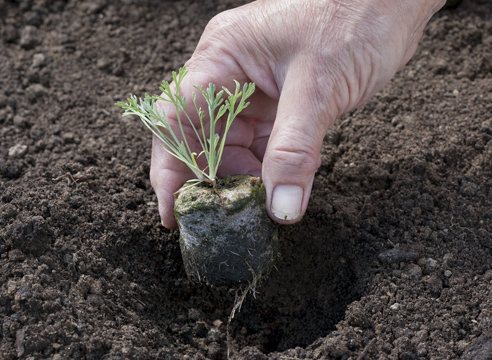

What time to plant
For planting escholzia, you should choose an area with sandy dry soil, which is well-drained, which should be slightly acidic or neutral. In the event that the soil is acidic, then this can be corrected by digging it to the depth of the shovel bayonet and at the same time adding 2 tbsp. wood ash or 0.2 kg of dolomite flour per 1 m2. Seedlings should be planted after the threat of return frosts has completely passed, depending on the region, it is carried out from April to mid-May.
Landing features
To begin with, not very large planting pits should be prepared on the site, while the distance between them should be about 0.3 m, since the Escholzia bushes are quite spreading. The plant should be immersed in the hole along with a peat tablet, then it is covered with soil, which is well compacted. The planted plants need to be watered. Flowering of such aescholzia is observed already 30–40 days after its sowing on seedlings.
When to plant Escholzia seedlings
Escholzia is propagated by seedlings. This method has several advantages: flowering begins earlier and plants suffer less from weeds. If the seeds are planted directly into open ground, then the seedlings may die when the temperature drops.
When choosing the timing for planting seeds, they are guided by weather conditions. In the southern regions, they are planted in March, in the middle lane - from April to May. Seedlings are transferred to open ground at the age of 30 - 45 days.
Before choosing the timing of planting seeds, take into account the duration of daylight hours. If twilight comes quickly, then provide a backlight. However, it is easier to postpone work for a few weeks when daylight hours increase.
The frequency of spring frosts in the region is of great importance. Seedlings are planted in a permanent place when the soil warms up well and cold snaps pass. Therefore, in cooler climates, it is best to plant the Escholzia seeds later.
Care features
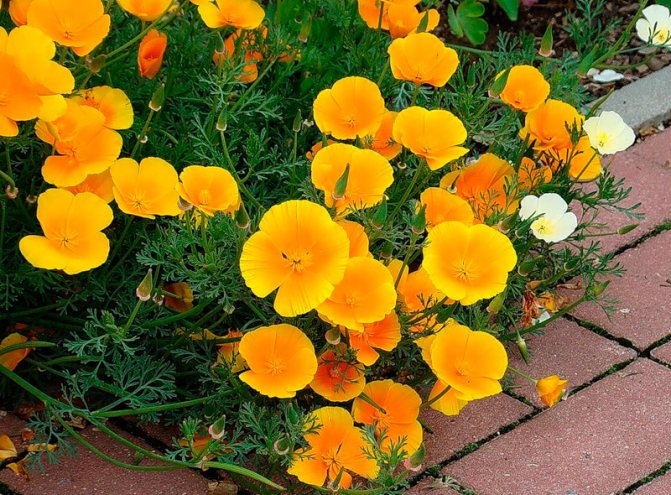

After the escholzia is planted in open soil, it will need to ensure systematic loosening of the soil surface, and it also needs to be fertilized on time. Watering should only be done when there is a prolonged dry period. If it rains systematically in the summer, then these flowers will not need watering. If you want escholzia to bloom for a very long time and magnificently, then before the beginning of the flowering period it should be fed with a complete mineral fertilizer, which must necessarily include phosphorus, potassium, nitrogen and trace elements, or you can use an ash infusion in a ratio of 1:10. Do not feed these flowers with fresh organic matter, as this can lead to their death. It should be remembered that escholzia reproduces well by self-seeding, if this is not included in your plans, then you just need to remove flowers that have begun to fade in a timely manner. When the bush has completely bloomed, you need to cut off all its old stems, and after a short period of time, young ones will appear in their place, which will begin to bloom in just 15–20 days.
Diseases and pests
Remember, so that you do not have any problems with growing this plant, you need to properly care for it, as well as provide suitable conditions for its growth. For example, if you violate the rules of agricultural technology and care, then leguminous aphids can settle on the bushes. To get rid of it, it is necessary to process the affected specimens by the Commander. If the summer period is very hot and dry, then spider mites can settle on Escholzia. To get rid of these pests, use the Actellic insecticide. If the plant is watered very abundantly, rot may appear on its roots and ground parts. In this case, it is necessary to sharply reduce watering and cut out all the affected areas. In the event that the flower is very rotten, then it will be necessary to dig up and destroy the entire bush. If the plant becomes infected with powdery mildew, then it must be treated with sulfur.
Diseases and pests
In hot dry summers, a spider mite can settle on the plant. In a short time, this pest can spoil the appearance of the culture and even destroy the escholzia. Pest control measures - spraying infected plants with systemic anti-tick drugs. The treatment should be repeated after 7-10 days, when new mite offspring hatch from the eggs.
Ticks attach themselves to the bottom of the leaves, so it is imperative to spray medications under the leaves of the plants.
In addition to the spider mite, the bean aphid is a pest of escholzia; special preparations against aphids will help to destroy the pests.
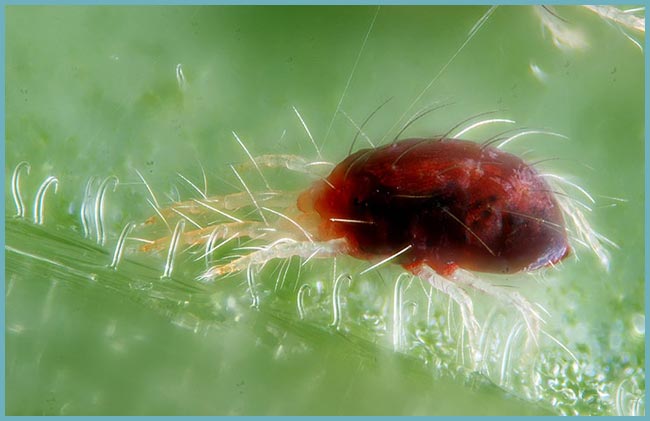

Spider mite
Overflowing soil can cause the roots of Escholzia to rot. Damaged plants should be removed from the beds and flower beds.
Escholzia properties
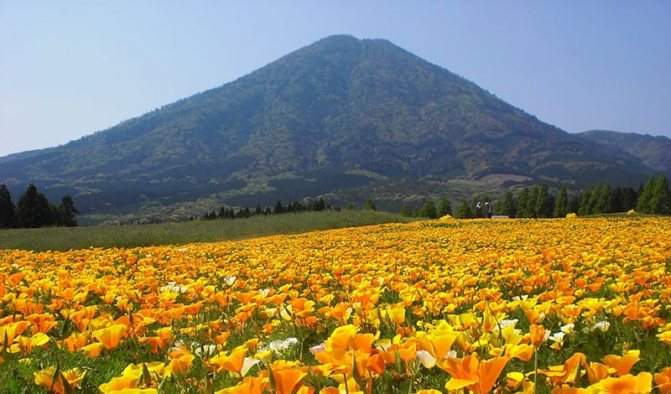

For a long time, the aerial parts of such a plant were used by the American Indians as an analgesic for toothaches, while the pollen collected from its flowers was an excellent cosmetic product. A decoction was made from the flowers of escholzia, which perfectly helped with head lice. Today, in the United States, preparations from such a plant are used in pediatrics as a sedative and analgesic agent, while in France it is grown on an industrial scale and used as a raw material for the pharmaceutical industry. These drugs have one tangible advantage - they do not have unwanted side effects, which is very rare for benzodiazepine drugs.
Escholzia seedling care
Echscholzia seedlings require certain conditions to be met. This includes watering and feeding. Be sure to monitor the level of moisture in the soil and air. In order for the seedlings to better adapt to natural conditions, they begin to harden them.
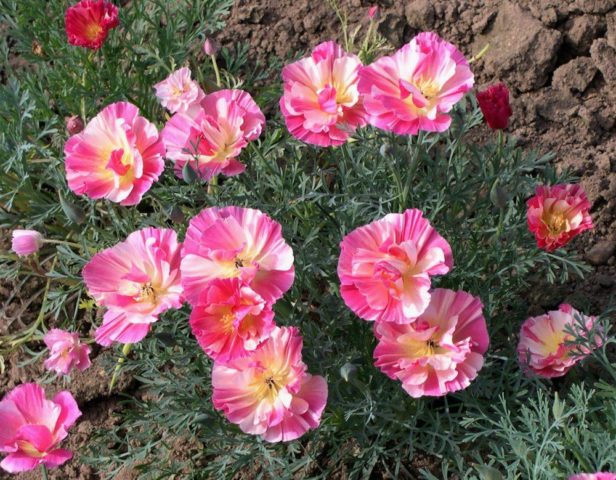

Proper watering
Eshcholzia seedlings are watered as the soil dries up. It is best to use soft warm water. It is introduced using a finely dispersed spray bottle. The soil is carefully sprayed, while trying to prevent moisture from getting on the leaves and stems of the plants. The excess water accumulating in the pan is drained.
Attention! Hard tap water is softened with citric acid or oxalic acid.
Seedlings are watered in the morning or evening. Water should not stagnate in the ground. High humidity provokes fungal diseases. The most dangerous of them is the black leg. The disease leads to stem decay and the appearance of dark spots on it. As a result, seedlings die.
Top dressing
If the seedlings develop normally, then fertilization can be dispensed with. If the plants suffer from a lack of light and look oppressed, then additional feeding is required. For seedlings of flowers, complex fertilizers are used: Nitrofoska, Kemira, etc. If the seedlings develop slowly, then they resort to growth stimulants: Epin, Zircon, etc.
Echscholzia seedlings, obtained from seeds at home, are fed no more than once every 7 to 10 days. If the plants have pale green leaves, this is a sign of nitrogen deficiency. Then the seedlings are fed with a solution of urea or mullein. It is recommended to alternate mineral and organic feedings.
If the seedlings have purple leaves and stems, this is a sign of a lack of phosphorus. Eschsholzia in this case is fed with a superphosphate solution. This requires 2 g of fertilizer per 1 liter of water. The resulting solution is applied at the root.
A lack of potassium is indicated by yellowed leaves with dried out tips. Potassium sulfate is used for feeding. The concentration of the substance per 1 liter of water is 3 g.
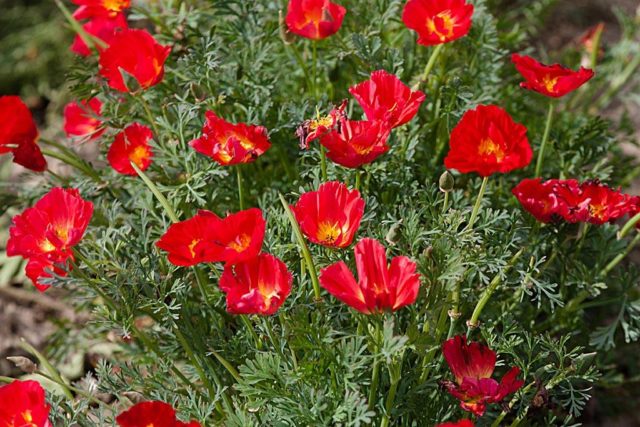

Hardening
Transplanting to a permanent place is stressful for any flower. To make the escholzia better tolerate this process, hardening the seedlings will help. As a result, plants take root faster in the garden, get sick less and acquire high immunity.
Echscholzia seedlings are hardened 2 - 3 weeks before planting in the ground. First, the window is opened in the room for 2 - 3 hours. This ensures an inflow of fresh air. In this case, the senses should not be in a draft.
After a few days, the seedlings are transferred to a balcony or loggia. At first, the plants are shaded from the bright sun using paper caps.Immediately before disembarking, the escholzia should be constantly outdoors.
Escholzia after flowering
Seed collection
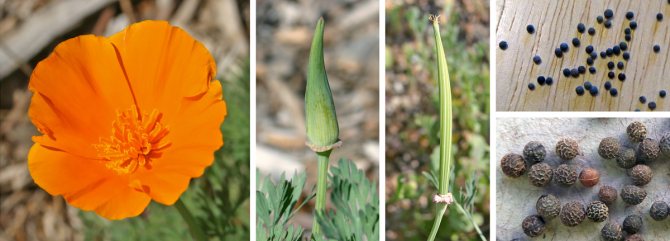

In the event that you decide to collect the seeds of Escholzia in order to sow them in the autumn or spring, then you do not need to do this, since these flowers reproduce very well by self-sowing. All that needs to be done is to thin out the seedlings in the spring and wait for a lush flowering. Seeds are necessary if you are just starting to cultivate such a beautiful plant or decide to give them to someone. To prevent the seeds from spilling out on the ground, bags made of gauze should be put on several wilting flowers. Then you need to wait about 4 weeks, as the seeds should ripen well. Then the boxes are cut off and seeds are extracted from them on a newspaper leaf at home. They should be thoroughly dried and placed in a paper bag, which is placed on the bottom shelf of the refrigerator, where the seeds will be stored until spring. If done correctly, the seeds will remain viable for three years.
Preparing for winter
Despite the fact that there are perennial species of escholzia, in middle latitudes, these flowers are cultivated only as an annual or biennial. In this regard, in the autumn, it will be necessary to cut off the remains of plants and dig up the site. In spring, strong seedlings will definitely appear on the site. They should be thinned and fed, and after 4 weeks such plants will please you again with their spectacular and lush flowering.
Description
The height of herbaceous bushes is 15-50 cm. They are formed from many shoots with a pronounced main stem. The root system is pivotal, develops rapidly and goes deeper, so the plants hardly tolerate transplanting. The leaf plate is bluish-green, strongly dissected, consists of three openwork parts, has a waxy coating, a bit like wormwood. At the base of the stem, the leaves are folded into a lush silvery rosette.
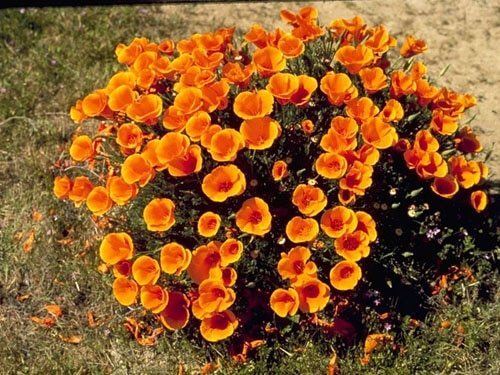

Californian eschsholzia
Escholzia flowers are single, in the form of a bowl or cap, similar to small poppies, 2-8 cm in diameter. The corolla is most often simple, terry in varietal forms. Colored can be bright orange, yellow, cream, pink, white or red. In the evening, in cloudy and rainy weather, the flowers close. The flowering period is long, from June to early October. But each individual flower only lives for 3 days. The fruit is a capsule with very small seeds.
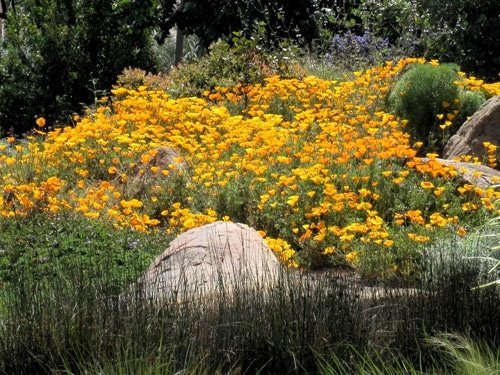

Escholzia in a rocky garden
Types and varieties of escholzia with photos and names
Gardeners of middle latitudes cultivate, as a rule, only Aescholzia turfy, Californian, and quite rarely Aescholzia lobby.
Eschscholzia lobbi
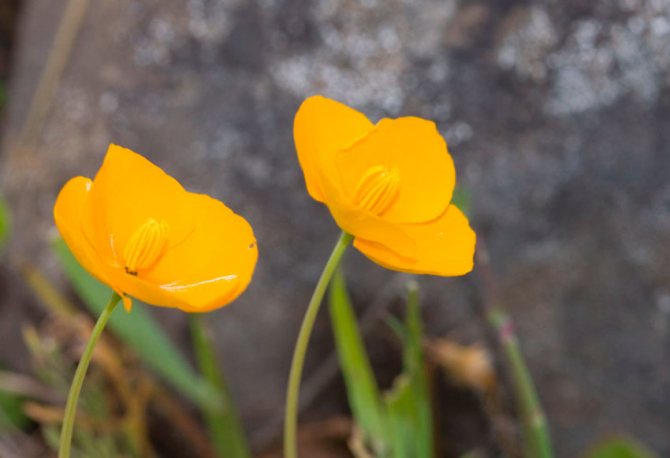

The bush reaches a height of no more than 15 centimeters. The diameter of the pale yellow flowers reaches 20 mm.
Sod Eschscholzia (Eschscholzia caespitosa)
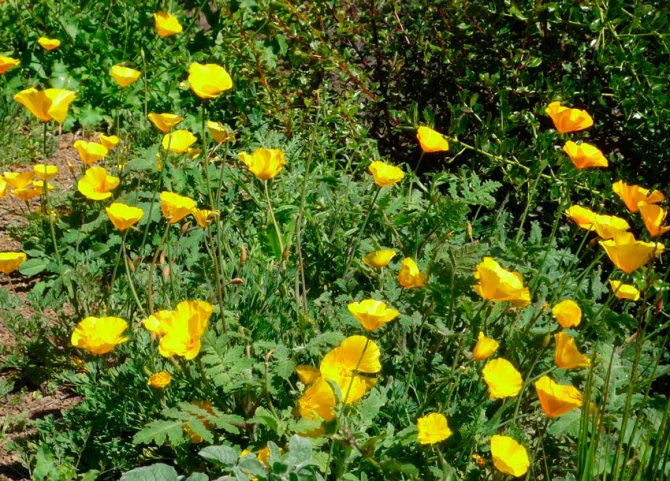

The height of this species also does not exceed 15 centimeters. The leaf rosette consists of three times dissected thin leaf plates, on their surface there is a coating of wax, and they are painted in a greenish-gray color. Above the rosette there is a dense inflorescence consisting of deep yellow cupped flowers, the diameter of which is approximately 30 mm. Flowering begins in June and ends before the onset of winter.
Californian Eschscholzia (Eschscholzia californica)
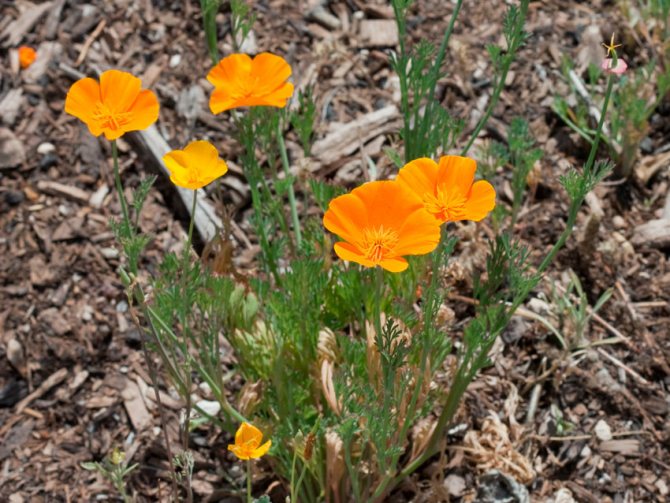

This species is outwardly similar to the wild poppy, and it is then called "Californian poppy". This creeping, branched herbaceous shrub is a perennial, its height does not exceed 0.4 m. It has a large number of thin greenish-gray ribbed shoots that are located on the stem. They are covered with light-gray, triple dissected leaf plates. The diameter of single cupped flowers is about 9 centimeters, they can be painted in white, orange, yellow, cream or carmine color. Flowering is very lush, it is observed from June until the onset of the first frost.The most popular varieties:
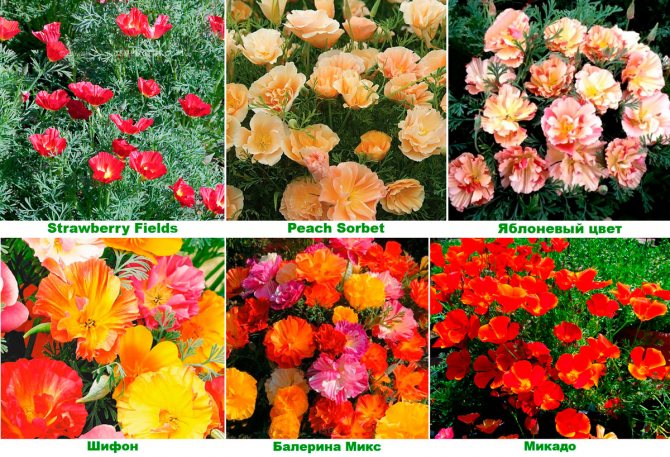

- Strawberry fields... The flowers are colored at the edges in a deep red color, which changes to yellow in the middle.
- Peach sorbet... Terry delicate flowers have a cream color.
- Simple flowers are dark carmine in color.
- Apple blossom... Sufficiently large double flowers have a color similar to apple blossom.
- Chiffon... This is a mixture of seeds, which includes plants of various colors and sizes, they are recommended for decorating borders or lawns. The height of the bushes can vary from 0.35 to 0.4 m. Terry flowers have corrugated edges. They can be painted in deep pink, red, yellow or white, while several shades are combined in one flower. Flowering begins in May and ends with the onset of frost.
- Ballerina Mix... This mixture consists of simple and terry varieties. The color of the flowers can be yellow, orange or pink. Their diameter is 5–8 centimeters. The height of the bushes varies from 0.25 to 0.4 m. There is a coating of wax on the surface of the three times dissected leaf plates.
- Mikado... The height of the bush varies from 0.3 to 0.4 m. The diameter of simple flowers is 6-7 centimeters. Their color is deep yellow, with a large orange spot in the middle.
Plant species
The variety of escholzia is not numerous and has only 12 plant species. Only 2 types of culture are popular among gardeners. There are ornamental garden varieties that have been bred by breeders specifically to diversify the assortment of escholzia. Let's get to know them better.
California escholzia or poppy
The plant has thin branchy shoots, which are covered with dark green shoots with a light smoky color. The height of the Californian poppy reaches 40 cm, but because of the thin branches, some of the processes tend to the ground. The foliage also has a light dark gray coating. The flowers are usually bright orange, cupped buds of medium size - 9 cm in diameter. Blooms before the onset of the autumn cold.
The most famous varieties:
- Strawberry field - the color of the buds is rich scarlet, the core is yellow.
- The color of the apple tree is a representative of double varieties, the flowers are large, pink in color, the petals are lighter towards the center of the bud.
- Mikado - small yellow buds with a bright orange core.
- Apricot chiffon is also a representative of the terry subspecies, apricot-colored buds with a light creamy note. The petals differ from other varieties in a corrugated structure.
- Fruit explosion - large buds, with wide petals, varied color - pink, rich crimson, yellow, turning into orange.
- The ballerina is a terry escholzia, it has a large bud diameter - up to 15 cm, the color of the petals is always bright, regardless of the color.
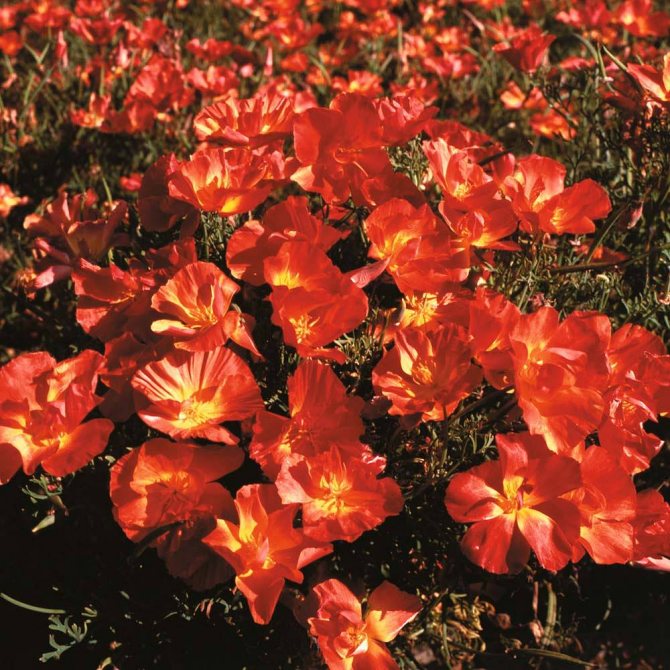

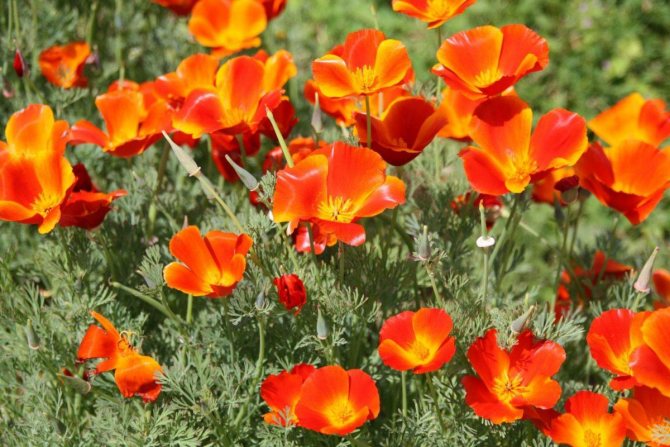

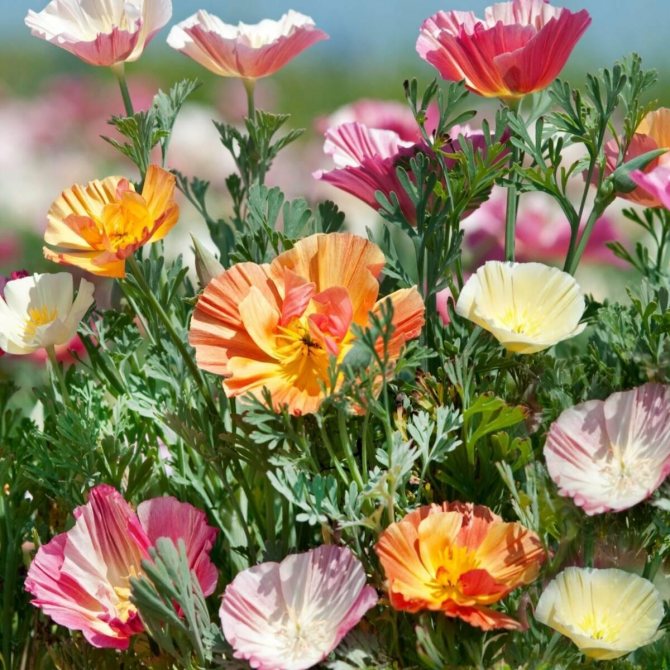

Soddy escholzia
This variety belongs to an annual subspecies. It grows in medium compact sizes (15-20 cm), suitable for refining flower beds, alpine slides and other landscapes on the site. The foliage is collected by small rosettes in the root zone of the plant. The buds are bright yellow, medium-sized (up to 3 cm). Blooms in June.
